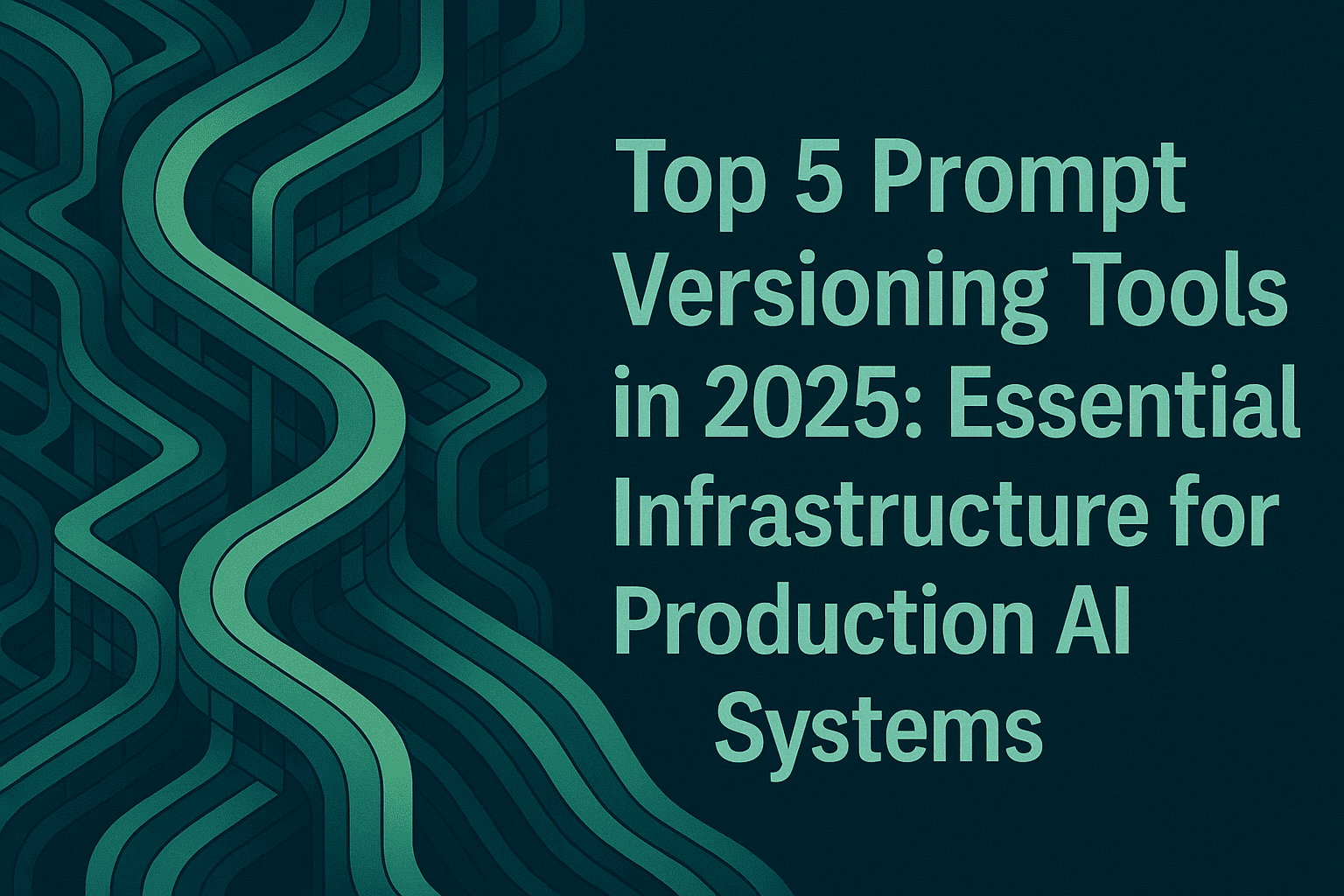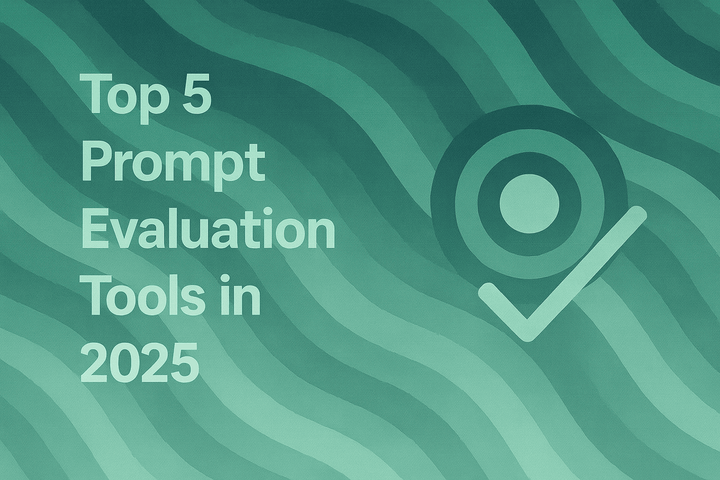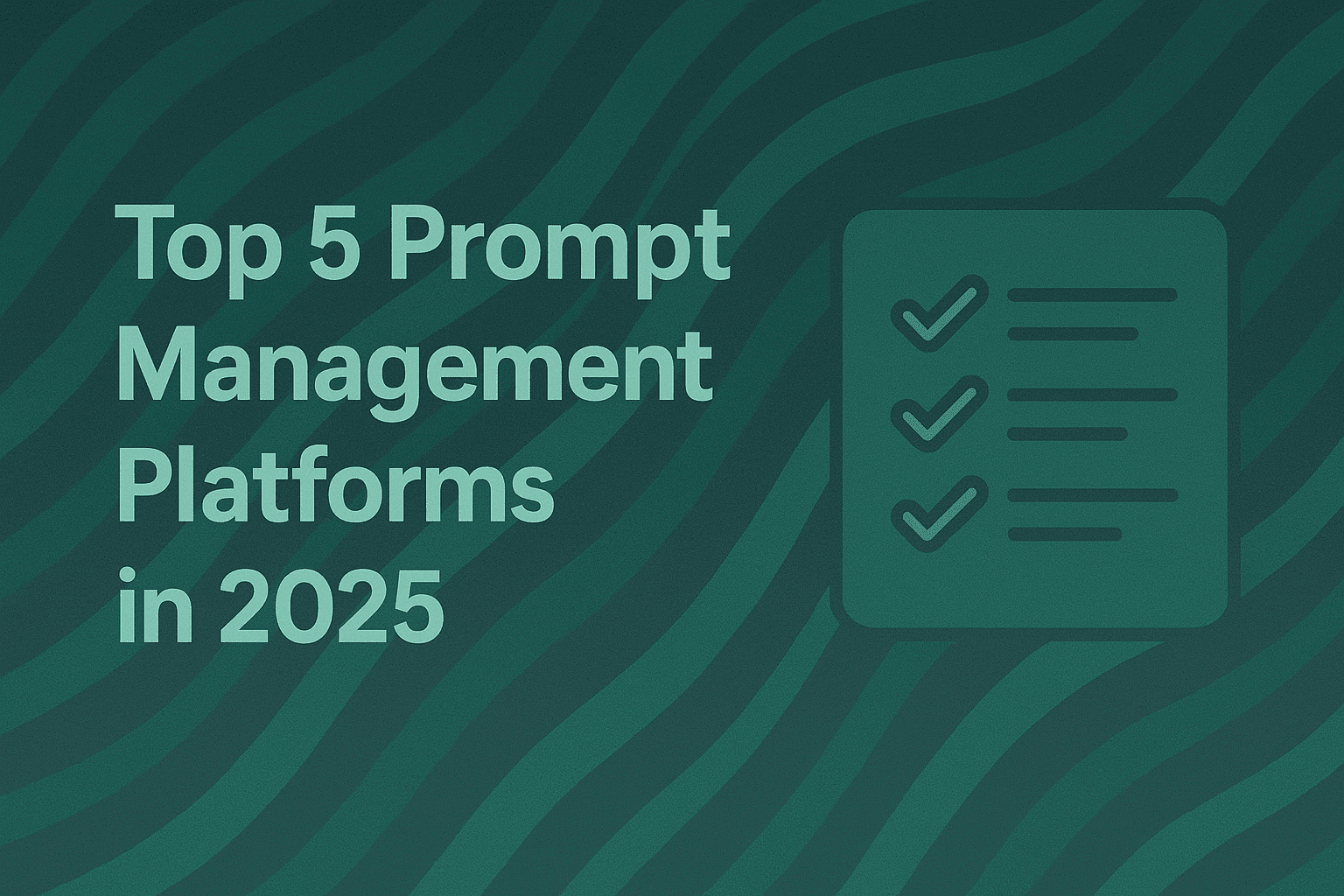Get Started with Prompt Management (2025 Guide)

TL;DR:
Prompt management is the systematic approach to organizing, versioning, and testing AI prompts at scale. It lets teams version, test, and deploy prompts independently without engineering bottlenecks. This guide covers 5 essential best practices and how platforms like Maxim AI streamline enterprise prompt management.
Introduction
As LLMs become deeply embedded in products and workflows, prompt management has emerged as a critical discipline for teams building LLM-powered applications. Effective prompt management tools ensure consistent, safe, and high-quality AI outputs while enabling rapid iteration and collaboration at scale for building reliable AI applications.
In this article, we explore prompt management best practices and trends for 2025, and how platforms like Maxim AI empower teams to version, test, optimize, and experiment with their prompts seamlessly.
What Is Prompt Management and Why AI Teams Need It in 2025
Prompt management is the process of organizing, versioning, testing, and optimizing the inputs (prompts) sent to AI models to elicit the best possible outputs. Unlike ad-hoc prompting, it treats prompts as valuable code assets that require collaboration, experimentation, and observability.
Why This Matters
- AI outputs are highly sensitive to prompt wording, structure, and context
- Poorly managed prompts lead to inconsistent or unreliable results
- Cross-functional teams need to collaborate on designing prompts and tracking changes over time
- Prompts require continuous iteration to ensure superior end-user experiences
- Scaling AI-powered products demands prompt reuse, auditing, and continuous improvement
Common Challenges in Scaling Prompt Management
As AI applications mature, prompt management becomes critical for maintaining reliability, scalability, and compliance. Managing hundreds of prompts across models introduces new layers of complexity, making prompt management essential for production.
- Managing Multiple Models: Teams work with GPT-4, Claude, Gemini, or custom models, each requiring different prompt formats and optimization strategies. Without a unified prompt management platform, teams maintain separate repositories, leading to duplication and inconsistency.
- Fragmented Workflows: Prompts often live across documents, notebooks, or codebases, creating silos and duplication. A unified prompt management platform brings them together for easier tracking and collaboration.
- Version Control Chaos: Without prompt versioning, small wording changes can lead to unpredictable model behavior. Effective prompt version control allows A/B testing, rollback, and reproducibility.
- Lack of Observability: Teams rarely know which prompt version performs best. Adding prompt observability and analyticsensures continuous improvement and data-driven refinement.
- Compliance and Governance: Enterprises in regulated industries require audit trails, access controls, and approval workflows to meet compliance standards.
- Collaboration Bottlenecks: Product managers, data scientists, and engineers need a shared prompt testing environment instead of ad-hoc spreadsheets and Slack threads.
A well-structured prompt management workflow, from drafting and versioning to testing and deployment, addresses these issues, ensuring every prompt is measurable, traceable, and production-ready.
Prompt Management vs. Hardcoded Prompts
| Aspect | ❌ Hardcoded Prompts | ✅ Prompt Management |
|---|---|---|
| Updates | Code deployment required | Update without redeploying |
| Version Control | No tracking | Git-like versioning with history |
| Testing | Manual, inconsistent | Automated A/B testing |
| Collaboration | Engineers only | Cross-functional teams |
| Rollback | Requires code revert | One-click rollback |
| Monitoring | No visibility | Real-time performance tracking |
| Compliance | No audit trail | Full audit logs + approvals |
| Scale | Breaks at 10+ prompts | Handles hundreds of prompts |
Bottom line: Hardcoded prompts work for prototypes. AI in production needs proper prompt management software.
Prompt Management Best Practices (2025)
1. Lead with Clear Instructions
Start every prompt with a concise, outcome-based instruction so the model understands the goal immediately.
Instead of:
"Hey, GPT, can you revise this email?"
Use:
"Revise the following email to sound more professional and reduce word count by 30%."
Clear instructions reduce ambiguity and make outputs measurable, which helps during evaluation and version comparison later.
Teams that manage prompts systematically often version these instruction variants, test them across models, and record which ones consistently deliver the best results.
2. Design Role-Based Prompts for Safety
Assign roles or personas within prompts to guide AI behavior safely and effectively.
Example:
“You are a HIPAA-compliant medical assistant. Never share patient identifiers or provide specific medical diagnoses.”
Role-based prompts help prevent prompt injection and data leakage, especially in domains like healthcare or finance.
Cross-functional reviews, where product managers, compliance teams, and engineers evaluate prompts together, ensure the output is not only safe but also aligned with product goals and user experience.
3. Use Structured Formats and Delimiters
Use quotation marks, XML tags, or numbered sections to clearly separate instructions, context, and data.
Example:
<instruction>Summarize customer feedback</instruction>
<context>Product: SaaS analytics platform</context>
<data>"The dashboard is great but loading time is slow..."</data>
<output_format>3 bullet points, each under 15 words</output_format>
Structured formatting helps models follow complex, multi-step tasks consistently.
Prompt management tools make this process easier by providing intuitive interfaces where prompts can be organized, compared, and evaluated side by side. Approved versions can then be deployed quickly into production without engineering overhead.
4. Version, Test, and Track Prompts Like Code
Just like software code, prompts should be versioned and tracked to understand changes, roll back if needed, and run experiments to detect quality regression.
Best practices:
- Use semantic versioning (v1.0, v1.1, v2.0)
- Tag production vs. staging prompts
- Document why each change was made
- Run A/B tests before promoting to production
5. Monitor Prompt Performance Continuously
AI models and use cases evolve, so prompt management requires ongoing monitoring of outputs, user feedback, and logs to identify failures or drift.
Key metrics to track:
- Response accuracy rate
- Latency (P50, P95, P99)
- Cost per request
- User satisfaction scores
- Hallucination/error frequency
How Maxim AI Streamlines Prompt Management for Enterprises
While many teams struggle with ad-hoc prompt handling, Maxim AI offers a unified prompt management platform purpose-built for production AI applications with integrated evaluation and observability.
Centralized Prompt Versioning
Track prompt changes, compare versions, and collaborate across teams with full audit trails. Every change is logged with author, timestamp, and rationale.
A/B Testing and Evaluation at Scale
Run automated A/B tests on prompt variants across multiple models (GPT-4, Claude, Gemini) to identify the best-performing versions. Maxim AI's integrated prompt testing evaluates prompts against custom criteria before production deployment.
Prompt Security and Governance
Implement role-specific prompt templates that enforce safe AI behaviors and reduce prompt injection risks. For enterprise prompt management, Maxim AI provides:
- Role-based access controls (RBAC)
- SOC 2 / HIPAA compliance tracking
- Adversarial prompt detection
- Data residency controls for enterprise compliance
Full Observability for AI Agents
Monitor and evaluate AI agents in pre-production and post-production with real-time prompt observability. Catch failure modes early with automated alerts and performance dashboards.
Seamless Agent & Workflow Integration
Manage prompts alongside agent simulation, evaluation, and observability for end-to-end AI lifecycle control. Maxim AI integrates with existing CI/CD pipelines for prompt management as code.
By treating prompts as core assets and embedding prompt management into the AI development workflow, Maxim AI helps teams ship AI products faster, safer, and with higher confidence.
Emerging Trends & Prompt Management Tools to Watch in 2025
The prompt management landscape is rapidly evolving. Here are key trends shaping 2025:
Automated Prompt Optimization
AI-powered tools now suggest prompt improvements based on performance data. Teams adopting continuous integration and deployment (CI/CD) pipelines for prompts automate testing and rollout, ensuring prompt updates evolve smoothly alongside model changes.
Prompt Security & Injection Defense
Increasing focus on safe prompt engineering to prevent adversarial attacks. New frameworks detect prompt injection attempts and implement guardrails to maintain AI safety in production environments.
Prompt Management as Code
Treating prompts like code artifacts with CI/CD pipelines and automated testing. Teams store prompts in Git repositories with pull request workflows and automated regression testing.
Prompt Reuse Across Models
Prompt management enables prompt reuse across different AI models and frameworks. Write once, deploy to GPT-4, Claude, and Gemini with automatic format translation.
FAQs About Prompt Management
What are the best prompt management tools in 2025?
Leading prompt management tools include Maxim AI (unified platform with observability), Langfuse (open-source option), AWS Bedrock Prompt Management (for AWS-native teams), and Arize Phoenix (for ML teams). Choose based on your tech stack, team size, and compliance needs.
How do you test and version LLM prompts?
Use prompt versioning systems that track changes like Git. Test prompts through A/B experiments, comparing outputs across models and versions. Monitor key metrics before promoting prompts to production.
What is prompt observability?
Prompt observability means tracking how prompts perform in production by monitoring outputs, costs, latency, and failure rates in real-time. It helps teams detect when prompt performance degrades and quickly diagnose issues.
How is prompt management different from prompt engineering?
Prompt engineering is the craft of writing effective prompts. Prompt management is the system for organizing, versioning, testing, and deploying those prompts at scale across teams and production environments.
Conclusion
Prompt management is no longer optional for teams building AI products; it's a foundational capability that drives quality, safety, and scalability. By adopting best practices like clear instructions, role-based design, structured formatting, and continuous monitoring, teams can unlock the full potential of LLMs.
However, scaling these practices across teams, models, and deployment environments requires purpose-built tooling. Platforms like Maxim AI provide the infrastructure to version prompts, automate testing, monitor production performance, and collaborate across Product and Engineering, turning prompt management from an ad-hoc process into a repeatable, governed system.
Ready to ship reliable AI faster? Try Maxim AI free or book a demo to see how teams manage prompts at scale.
Related Resources:


